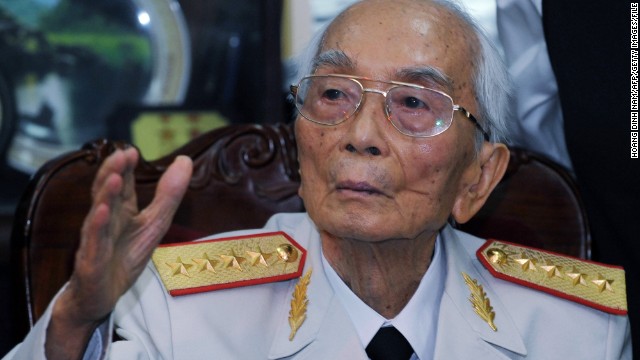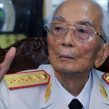
Hot Issue: The Jihadist Legacy of Vietnam’s General Vo Nguyen Giap
By:

General Vo Nguyen Giap, the diminutive military giant and author of the military defeats of both the French and the United States in Vietnam, died on October 4 at the age of 102. In a career that began with guerrilla attacks on Vichy French outposts in 1944 and culminated in the 1965-1975 war against conventional American troops and their South Vietnamese allies, Giap’s war against the West stretched over three decades.
One could say that the strategy employed by Giap against America continues even today because his guerrilla doctrine is at the base of al-Qaeda’s own version of guerrilla doctrine and strategy in their quest to defeat the United States. Students of military history might say that Giap’s military concepts are not only developments of Mao Tse-tung’s military thought, but can also be traced to ancient Chinese military texts attributed to 6th century B.C.E. general Sun Tzu. Some of these students wrote strategic studies for al-Qaeda and fellow jihadists before and after 9/11, using Giap’s People’s War People’s Army: The Viet Cong Insurrection Manual for Underdeveloped Countries as a practical guide.
A Strategist for All Seasons
After the United States and Vietnam finally ended their period of hostility, a visit to Giap became a destination of choice by former adversaries interested in the history of the war in Vietnam or simply interested in the man. One famous American adversary and hero of the war in Vietnam, Senator John McCain, recently wrote about his own visit to the aging general (Wall Street Journal, October 6). Arguing that Giap’s strategy was based on the wanton sacrifice of the lives of his soldiers and countrymen, McCain captured the essence of the struggle in a few terse, insightful sentences:
Today, Giap’s strategy, an elaboration and practical application of Mao’s guerrilla doctrine, lives on in an unlikely space—al-Qaeda’s doctrine of regional insurgency and global resistance. Like Senator McCain, al-Qaeda finds it impossible to admire Giap’s ideology, but in a distorted image of the Senator’s view they find his strategy moral as well as effective as adapted to their own purposes. Al-Qaeda’s leadership has long believed that their Western adversaries will tire “of the dying and the killing” before they do.
How Giap Fits in al-Qaeda’s Strategic Doctrine
Before al-Qaeda, classic guerrilla warfare had been a feature of anti-colonial insurgencies in the Middle East and North Africa, often carried out by native veterans of Europe’s colonial armies who received training in guerrilla techniques from pro-Soviet revolutionary cadres. The legacy of this training can be seen in early al-Qaeda documents found inside al-Zawahiri’s hard disc recovered in Afghanistan. [1] Even before 9/11, the author of one such document defined guerilla war as “a political-military technique of revolutionary war that the materially weaker side employs when it is disadvantageous to confront a conventional force [directly].” The author of this document apparently assumed that some readers might be unfamiliar with the term “guerrilla” and thus provides two variations of it in Arabic and includes the French term guerre de guerrilla for those who might be unclear about the Arabic terminology. [2]
These terms soon became quite familiar after al-Qaeda’s leadership started rethinking its strategy in the aftermath of the fall of the Taliban regime and al-Qaeda’s subsequent flight from Afghanistan. This strategic thinking began partly as an apparent effort to convince a skeptical Muslim audience that the 9/11 attacks and declarations that the United States is the main enemy of Islam did not constitute a fool’s errand; and partly as a genuine effort to provoke systematic thinking about war by al-Qaeda’s mid-level leaders once it became apparent that the technically overwhelming American military involvement in Afghanistan would not replicate the Soviet experience.
Al-Qaeda strategists (whether in documents or videos) are not quick to cite authorities outside of the movement’s core of sympathizers unless the citation forms part of a criticism of the United States and its allies. However, General Giap, along with other followers of Mao’s military-political thinking, appeared to al-Qaeda authors to provide an excellent roadmap for how a weak adversary can defeat a more powerful military, or, in the case of Vietnam, even the most powerful in the world. In his last major work on jihadist history and strategy, the Syrian jihadist strategist and trainer Abu Mus’ab al-Suri gave one of the clearest examples of this respect for Maoist thinking about guerrilla war. Al-Suri makes the point that to use a fixed-point defense at the wrong time (as at Tora Bora) leads to disastrous consequences for guerrillas and provides a number of modern examples. He then adds that these examples confirm everything that he has studied and taught and points out that this truth "is elaborated in the books of the greatest theorists of military art, such as Mao Tse-tung, [Ché] Guevara, Giap, and [Fidel] Castro." [3]
In fact, part of what al-Suri studied and taught was The War of the Oppressed, the Arabic translation of American journalist Robert Taber’s 1965 study of guerrilla warfare, The War of the Flea. Al-Suri called Taber’s book one of the best available on guerrilla warfare. [4] He thought it so important that he recorded his lectures on it in three versions (two, six or thirty-two cassettes) so that it could be copied and listened to by jihadists without requiring them to travel from their home countries. Taber’s short book contained two chapters on Giap’s role in the defeat of both the French and the United States in Vietnam.
Technology or Strategy?
Another al-Qaeda fan of The War of the Flea and General Giap was Abu Ubayd al-Qurashi (a pseudonym for a strategist and advisor to Bin Laden). Al-Qurashi wrote a series of articles starting in 2002 for “Al-Ansar,” an al-Qaeda Arabic-language electronic journal. Every issue of the magazine had a section on strategic studies, for which al-Qurashi contributed a topical article that would be part propaganda and part military strategy. His first article, published on January 15, 2002, was entitled “Al-Qaeda and The Art of War.” Al-Qurashi used the classic Chinese military text attributed to Sun Tzu to make his case that the American army had not paid sufficient attention to strategy because its leaders thought that superior technology made strategy irrelevant. Al-Qurashi used the example of Vietnam to make his case. According to this author, the American military traditionally does not learn easily from the experiences of others, especially after the euphoria of its victory in World War II. However, al-Qurashi argues that “after soaking their pride in the soil of the Vietnam war,” the American military returned to analyzing historical strategies and produced many valuable works, including studies of ancient Chinese military strategy. After the U.S. victory over Saddam Hussein in the Gulf War of 1990, however, al-Qurashi asserted that these lessons were lost and the United States reverted to relying on military technology instead of strategy.
Even before 9/11, al-Qurashi had written an article entitled “Revolutionary Wars,” published on a now defunct website. He wrote this article for three reasons:
- These wars offered a model of the weak fighting the strong with a good chance of victory;
- They received a great deal of attention in theoretical studies;
- Jihadists had adopted many of the techniques of these wars without fully understanding the basis for them. [5]
Citing People’s War People’s Army, al-Qurashi presents Giap’s definition of guerrilla war as “a type of warfare in which the weak side with poor equipment takes refuge among the masses to fight against a powerful enemy, which possesses superior equipment and technology.” [6] Al-Qurashi continues with the well-known hit and run tactics that Giap describes in detail, but more important are the virtues Giap ascribes to the guerrilla of patience and heroic zeal, the need for strong rear bases and the absolute necessity of waging a protracted war, the “long war” of al-Qaeda’s strategists. Finally, al-Qurashi adopts the most important lesson for guerrillas, or in this case jihadists—the political struggle, in which gaining international support is more important than the military struggle that is waged only to gain the objective of persuading the enemy forces or local government to withdraw. In the best case, the local government would eventually collapse because both the local population and the international community would have turned against it.
Giap’s Influence on the Jihad in Yemen and Elsewhere
These examples are not the only ones described by al-Qaeda strategists who rely on Giap’s concepts in developing their own jihadist version of asymmetric warfare. Abu Bakr Naji (a pseudonym) includes many of Giap’s ideas in his book The Administration of Savagery, which was endorsed by the current leader of al-Qaeda in the Arabian Peninsula (AQAP) as the blueprint that al-Qaeda is currently following in Yemen. Naji does not cite Giap by name, but he adopts his principles before referring his readers to al-Qurashi for more details. Naji describes a guerrilla system that, while eclectic, includes regions that replicate Giap’s strong rear bases in remote areas and a shift to urban areas only when the jihadists are strong enough. This is the system that is being used by al-Qaeda and al-Qaeda-sympathetic groups in northern Syria and by other militant groups in the Sahel.
Unlike Giap, Naji contemplates that these groups will not necessarily be cohesive, but would unite after they become strong enough to confront more powerful enemies directly. It is obvious that al-Qaeda’s strategy has not been successful, but neither has it been defeated. The movement’s strategists understand that the first job of the guerrilla is to survive and win the political battle locally and internationally. Following Giap’s example, they believe that patience, unreasoning sacrifice and a protracted war in which the West gets tired of “the fighting and dying” will lead to their ultimate victory. They are wrong, if we recognize their strategy for what it is and adjust our own accordingly. The West has won all the military battles so far; perhaps we need to concentrate on winning the political battles, or to use Naji’s Giap-derived dictum, “play the political game.”
Dr. Michael W. S. Ryan is an independent consultant and researcher on Middle Eastern security issues and a Senior Fellow at the Jamestown Foundation. He is the author of Decoding Al-Qaeda’s Strategy: The Deep Battle Against America (Columbia University Press, 2013).
Notes
1. Alan Cullison, who first obtained the computer in Afghanistan after al-Qaeda’s flight, generously offered a copy the contents of al-Zawahiri’s hard disk to the author. The document cited was in a folder titled Amn (Security) and the document itself was titled “Types of Wars.”
2. It may seem unreasonable to suggest that early al-Qaeda members would not know the Arabic term for guerrilla war; however, instances of this unfamiliarity by native speakers are apparent in early American translations of seized documents by civilian translators who interpreted the word used for guerrillas as bandits, which misses the fact that al-Qaeda uses the word ‘asabat in a specialized military sense.
3. See Abu Mus‘ab al-Suri, Da‘wah al-Muqawamah al-Islamiyyah al-Alamiyyah (The call to Global Islamic Resistance). Parts 1–2, December 2004. Castro is not known for writing theoretical books, but The War of the Flea devotes a chapter to his successful insurgency.
4. Ibid, p.1411 (PDF format) or p. 1133 (MSWord format). For Taber, see: Robert Taber, The War of the Flea, Washington D.C., Potomac Books, 2002, p. 58.
5. Michael W. S. Ryan, Decoding Al-Qaeda’s Strategy: The Deep Battle Against America, New York: Columbia University Press, 2013, p. 270.
6. Ibid, p 273. The Arabic text cites Giap’s work, but the quote from Giap is also found in Taber: The War of the Flea, p. 58.




